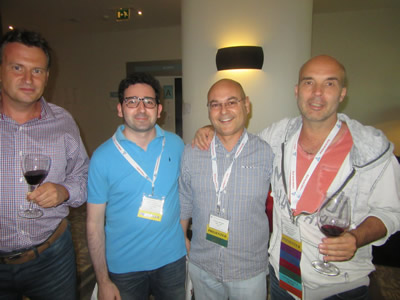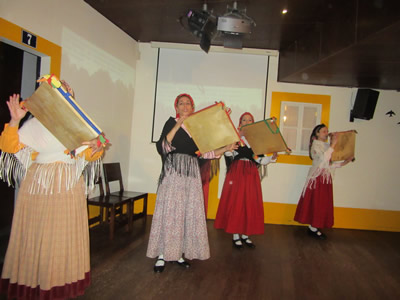BIOTECHNO 2025 - The Seventeenth International Conference on Bioinformatics, Biocomputational Systems and Biotechnologies
March 09, 2025 - March 13, 2025
BIOTECHNO 2025: Call for Papers
Onsite and Online Options: In order to accommodate various situations, we are offering the option for either physical presence or virtual participation (pdf slides or pre-recorded videos).
The initially separated events under the BIOTECHNO, BIOINFO, and BIOSYSCOM conferences are now grouped in a consolidated event covering the three mentioned areas (bioinformatics, biocomputational systems and biotechnologies).
Area A: Bioinformatics, chemoinformatics, neuroinformatics and applications
Bioinformatics deals with the system-level study of complex interactions in biosystems providing a quantitative systemic approach to understand them and appropriate tool support and concepts to model them. Understanding and modeling biosystems requires simulation of biological behaviors and functions. Bioinformatics itself constitutes a vast area of research and specialization, as many classical domains such as databases, modeling, and regular expressions are used to represent, store, retrieve and process a huge volume of knowledge. There are challenging aspects concerning biocomputation technologies, bioinformatics mechanisms dealing with chemoinformatics, bioimaging, and neuroinformatics.
Area B: Computational systems (genetics, biology, and microbiology)
Brain-computing, biocomputing, and computation biology and microbiology represent advanced methodologies and mechanisms in approaching and understanding the challenging behavior of life mechanisms. Using bio-ontologies, biosemantics and special processing concepts, progress was achieved in dealing with genomics, biopharmaceutical and molecular intelligence, in the biology and microbiology domains. The area brings a rich spectrum of informatics paradigms, such as epidemic models, pattern classification, graph theory, or stochastic models, to support special biocomputing applications in biomedical, genetics, molecular and cellular biology and microbiology. While progress is achieved with a high speed, challenges must be overcome for large-scale bio-subsystems, special genomics cases, bio-nanotechnologies, drugs, or microbial propagation and immunity.
Area C: Biotechnologies and biomanufacturing
Biotechnology is defined as the industrial use of living organisms or biological techniques developed through basic research. Bio-oriented technologies became very popular in various research topics and industrial market segments. Current human mechanisms seem to offer significant ways for improving theories, algorithms, technologies, products and systems. The focus is driven by fundamentals in approaching and applying biotechnologies in terms of engineering methods, special electronics, and special materials and systems. Borrowing simplicity and performance from the real life, biodevices cover a large spectrum of areas, from sensors, chips, and biometry to computing. One of the chief domains is represented by the biomedical biotechnologies, from instrumentation to monitoring, from simple sensors to integrated systems, including image processing and visualization systems. As the state-of-the-art in all the domains enumerated in the conference topics evolve with high velocity, new biotechnologes and biosystems become available. Their rapid integration in the real life becomes a challenge.
We solicit both academic, research, and industrial contributions. We welcome technical papers presenting research and practical results, position papers addressing the pros and cons of specific proposals, such as those being discussed in the standard fora or in industry consortia, survey papers addressing the key problems and solutions on any of the above topics short papers on work in progress, and panel proposals.
Industrial presentations are not subject to the format and content constraints of regular submissions. We expect short and long presentations that express industrial position and status.
Tutorials on specific related topics and panels on challenging areas are encouraged.
The topics suggested by the conference can be discussed in term of concepts, state of the art, research, standards, implementations, running experiments, applications, and industrial case studies. Authors are invited to submit complete unpublished papers, which are not under review in any other conference or journal in the following, but not limited to, topic areas.
All topics and submission formats are open to both research and industry contributions.
BIOTECHNO 2025 conference tracks:
A. Bioinformatics, chemoinformatics, neuroinformatics and applications
- Bioinformatics (Bioinformatics modeling; Bioinformatics databases; Epidemic models; Informatics and statistics in bio-pharmaceutical research; Machine learning and artificial intelligence in molecular design; Systems biology and metabolic networks; Medical informatics; Genomics informatics; Biostatistics; Structural and functional genomics; Identifying molecular sequence and structure databases; Mechanisms for specifying molecular interactions and structure predictions; Formalisms for gene regulation and expression databases; Algorithms for gene identification and pattern discovery; Techniques for gene expression analysis; Modeling and simulation of biomarkers)
- Advanced biocomputation technologies (Stochastic modeling; Computational drug discovery; Graph theory and bioinformatics; Biological databases and information retrieval; Experimental studies and results; Application of computational intelligence in medicine and biological sciences (artificial neural networks, fuzzy logic, evolutionary computing, and simulated annealing); High-performance computing as applied to natural and medical sciences; Hardware computing accelerators; Computer-based medical systems (automation in medicine, etc.); Other aspects and applications relating to technological advancements in medicine and biological sciences; Novel applications)
- Chemoinformatics (Computer-aided drug design; Concepts, methods, and tools for drug discovery; Virtual screening of chemical libraries; ADMET - absorption, distribution, metabolism, excretion, and toxicity; QSAR - quantitative structure-activity relationships; Protein-ligand docking and scoring functions; Chemical similarity and diversity; Chemogenomics in drug discovery; QSPR - quantitative structure-property relationships; Theoretical models in chemical reactivity; Mathematical chemistry and chemical graphs; In silico environmental toxicology; Computer-assisted chemical engineering; Combinatorial chemistry; Graph theory in chemistry; Prediction of drug toxicity; Property prediction; Molecular mechanics and quantum chemical calculations; Modeling and measurements of solid-liquid and vapor-liquid equilibria; Blood-brain barrier penetration; Comparison of the similarity(diversity of chemo-data libraries; Chemoinformatics applications)
- Bioimaging ( Image processing in medicine and biological sciences; Measurements techniques; Mass spectrometry; Numerical(mathematical approaches; Biological data integration and visualization)
- Neuroinformatics (Neurosciences; Neurocomputing)
B. Computational systems (genetics, biology, and microbiology)
- Bio-ontologies and semantics (Software environments for bio-computation, bio-informatics, and biomedical applications; Medical informatics; Epidemic models; Biological data mining; Biomedical knowledge discovery; Pattern classification and recognition; Mathematical biology; Graph theory and bio-informatics; Stochastic modeling; Biological databases and information retrieval; Processing mutation information; Archiving of mutation specific information)
- Biocomputing (Computational biology; Bioengineering; Biomedical image computing and informatics; Biomedical automation and control; Image-based diagnosis and therapy; Modeling and simulation of systems biology; Applications of large-scale bio-systems)
- Genetics (Gene regulation; Gene expression databases; Gene pattern discovery and identification; Genetic network modeling and inference; Gene expression analysis; RNA and DNA structure and sequencing; Evolution of regulatory genomic sequences; Biological data mining and knowledge discovery; Bio-pattern classification and recognition; Bio-sequence analysis and alignment; Comparative genomics; Structural and functional genomics; Amino acid sequencing)
- Molecular and Cellular Biology (Protein modeling; Molecular interactions; Metabolic modeling and pathways; Evolution and phylogenetics; Macromolecular structure prediction; Proteomics; Protein folding and fold recognition; Molecular sequence and structure databases; Molecular dynamics and simulation; Molecular sequence classification, alignment and assembly)
- Microbiology (Bio-nanotechnologies; Self-assembly and self-replication; Global regulatory networks and mechanisms; Microbial propagation and immunity; Microbial therapies; Microbial life under extreme energy limitation; Cellular microbiology and contact systems; Phylogenetics; Genome dynamics; Transmission dynamics and evolution of emerging diseases; Metagenomics and drug resistance; Microbes and alternative energies)
C. Biotechnologies and biomanufacturing
- Fundamentals in biotechnologies (Bioengineering; Bioelectronics; Biomaterials; Bio-films in ecology and medicine; Biometric screening techniques; Biorobotics)
- Biodevices (Biosensors; Biomechanical devices; Biochips; Biocomputing; Biometrics devices; Specialized biodevices; Nanotechnology for biosystems)
- Biomedical technologies (Biomedical engineering; Biomedical instrumentation; Biomedical metrology and certification; Biomedical sensors; Biomedical monitoring devices; Biomedical devices with embedded computers; Biomedical integrated systems)
- Biological technologies (Biological data integration; Image processing in medicine and biological sciences; Biological data visualization; Synthetic biological systems)
- Biomanufacturing (Manufacturing platforms; Biopharmaceutical industry; Generic biopharmaceuticals; Bioprocess management; Clinical trials; Disposables and product changeover; Upstream and downstream bioprocessing; Technology benchmarks; International regulations)
D. Bionature
- Bioenvironment (Climate; Hydrology; Wind science; Cryosphere; Public health; Economics; Responsibility)
- Biodiversity and invasion control (Marine & oceanic bio-technologies; Oceanic bio-diversity; Arctic and Antarctic bio-pulse; Forest landscape; Bioinvasion)
- Renewable and sustainable energies (Energy sustainability; Energy bioscience; Eolian energy; Photovoltaic solar energy; Biomass energy; Green energy technologies and economic models)
Deadlines:
Submission | Nov 22, 2024 |
Notification | Jan 06, 2025 |
Registration | Jan 19, 2025 |
Camera ready | Feb 02, 2025 |
Deadlines differ for special tracks. Please consult the conference home page for special tracks Call for Papers (if any).
INSTRUCTION FOR THE AUTHORS
Authors of selected papers will be invited to submit extended versions to one of the IARIA Journals.
Publisher: XPS (Xpert Publishing Services)
Archived: ThinkMindTM Digital Library (free access)
Prints available at Curran Associates, Inc.
How to submit to appropriate indexes.
Only .pdf or .doc files will be accepted for paper submission. All received submissions will be acknowledged via an automated system.
Contribution types
- regular papers [in the proceedings, digital library]
- short papers (work in progress) [in the proceedings, digital library]
- ideas: two pages [in the proceedings, digital library]
- extended abstracts: two pages [in the proceedings, digital library]
- posters: two pages [in the proceedings, digital library]
- posters: slide only [slide-deck posted on www.iaria.org]
- presentations: slide only [slide-deck posted on www.iaria.org]
- demos: two pages [posted on www.iaria.org]
FORMATS
Only .pdf or .doc files will be accepted for paper submission. All received submissions will be acknowledged via an automated system.
Final author manuscripts will be 8.5" x 11", not exceeding 6 pages; max 4 extra pages allowed at additional cost.
Helpful information for paper formatting for MS Word can be found here.
There is a community provided LaTeX template: the CTAN package iaria (with full IARIA formatting rules, including IARIA citation style, but for providing citation style it is tightly bound to pdflatex+biblatex+biber). In addition, there is also iaria-lite (not bound to pdflatex+biblatex+biber, but compatible with any TeX stack; thus, it cannot provide the IARIA citation formattings, but only the titlepage and content-related IARIA formatting rules). Based on the iaria package, there is a minimal working example as Overleaf template. When you are using the LaTeX templates, please still adhere to the additional editorial rules.
Slides-based contributions can use the corporate/university format and style.
Your paper should also comply with the additional editorial rules.
Once you receive the notification of contribution acceptance, you will be provided by the publisher an online author kit with all the steps an author needs to follow to submit the final version. The author kits URL will be included in the letter of acceptance.
We would recommend that you should not use too many extra pages, even if you can afford the extra fees. No more than 2 contributions per event are recommended, as each contribution must be separately registered and paid for. At least one author of each accepted paper must register to ensure that the paper will be included in the conference proceedings and in the digital library, or posted on the www.iaria.org (for slide-based contributions).
CONTRIBUTION TYPE
Regular Papers (up to 6-10 page article -6 pages covered the by regular registration; max 4 extra pages allowed at additional cost- ) (oral presentation)
These contributions could be academic or industrial research, survey, white, implementation-oriented, architecture-oriented, white papers, etc. They will be included in the proceedings, posted in the free-access ThinkMind digital library and sent for indexing. Please submit the contributions following the instructions for the regular submissions using the "Submit a Paper" button and selecting the appropriate contribution type. 12-14 presentation slides are suggested.
Short papers (work in progress) (up to 4 pages long) (oral presentation)
Work-in-progress contributions are welcome. These contributions represent partial achievements of longer-term projects. They could be academic or industrial research, survey, white, implementation-oriented, architecture-oriented, white papers, etc. Please submit the contributions following the instructions for the regular submissions using the "Submit a Paper" button and selecting the contribution type as work in progress. Contributors must follow the conference deadlines, describing early research and novel skeleton ideas in the areas of the conference topics. The work will be published in the conference proceedings, posted in the free-access ThinkMind digital library and sent for indexing. For more details, see the Work in Progress explanation page. 12-14 presentation slides are suggested.
Ideas contributions (2 pages long) (oral presentation)
This category is dedicated to new ideas in their very early stage. Idea contributions are expression of yet to be developed approaches, with pros/cons, not yet consolidated. Ideas contributions are intended for a debate and audience feedback. Please submit the contributions following the instructions for the regular submissions using the "Submit a Paper" button and selecting the contribution type as Idea. Contributors must follow the conference deadlines, describing early research and novel skeleton ideas in the areas of the conference topics. The work will be published in the conference proceedings, posted in the free-access ThinkMind digital library and sent for indexing. For more details, see the Ideas explanation page. 12-14 presentation slides are suggested.
Extended abstracts (2 pages long) (oral presentation)
Extended abstracts summarize a long potential publication with noticeable results. It is intended for sharing yet to be written, or further on intended for a journal publication. Please submit the contributions following the instructions for the regular submissions using the "Submit a Paper" button and selecting the contribution type as Extended abstract. Contributors must follow the conference deadlines, describing early research and novel skeleton ideas in the areas of the conference topics. The work will be published in the conference proceedings, posted in the free-access ThinkMind digital library and sent for indexing. 12-14 presentation slides are suggested.
Posters (paper-based, two pages long) (oral presentation)
Posters are intended for ongoing research projects, concrete realizations, or industrial applications/projects presentations. The poster may be presented during sessions reserved for posters, or mixed with presentation of articles of similar topic. A two-page paper summarizes a presentation intended to be a POSTER. This allows an author to summarize a series of results and expose them via a big number of figures, graphics and tables. Please submit the contributions following the instructions for the regular submissions using the "Submit a Paper" button and selecting the contribution type as Poster Two Pages. Contributors must follow the conference deadlines, describing early research and novel skeleton ideas in the areas of the conference topics. The work will be published in the conference proceedings, posted in the free-access ThinkMind digital library and sent for indexing. 8-10 presentation slides are suggested. Also a big Poster is suitable, used for live discussions with the attendees, in addition to the oral presentation.
Posters (slide-based, only) (oral presentation)
Posters are intended for ongoing research projects, concrete realizations, or industrial applications/projects presentations. The poster may be presented during sessions reserved for posters, or mixed with presentation of articles of similar topic. The slides must have comprehensive comments. This type of contribution only requires a 8-10 slide-deck. Please submit the contributions following the instructions for the regular submissions using the "Submit a Paper" button and selecting the contribution type as Poster (slide-only). The slide-deck will be posted, post-event, on www.iaria.org.
8-10 presentation slides are suggested. Also a big Poster is suitable, used for live discussions with the attendees, additionally to the oral presentation.
Presentations (slide-based, only) (oral presentation)
These contributions represent technical marketing/industrial/business/positioning presentations. This type of contribution only requires a 12-14 slide-deck. Please submit the contributions following the submission instructions by using the "Submit a Paper" button and selecting the contribution type as Presentation (slide-only). The slide-deck will be posted, post-event, on www.iaria.org.
12-14 presentation slides are suggested.
Demos (two pages) [posted on www.iaria.org]
Demos represent special contributions where a tool, an implementation of an application, or a freshly implemented system is presented in its alfa/beta version. It might also be intended for thsoe new application to gather the attendee opinion. A two-page summary for a demo is intended to be. It would be scheduled in special time spots, to ensure a maximum attendance from the participants. Please submit the contributions following the submission instructions by using the "Submit a Paper" button and selecting the contribution type as Demos. The Demos paper will be posted, post-event, on www.iaria.org.
Tutorial proposals
Tutorials provide overviews of current high interest topics. Proposals should be for 2-3 hour long. Proposals must contain the title, the summary of the content, and the biography of the presenter(s). The tutorial slide decks will be posted on the IARIA site.
Please send your proposals to tutorial proposal
Panel proposals
The organizers encourage scientists and industry leaders to organize dedicated panels dealing with controversial and challenging topics and paradigms. Panel moderators are asked to identify their guests and manage that their appropriate talk supports timely reach our deadlines. Moderators must specifically submit an official proposal, indicating their background, panelist names, their affiliation, the topic of the panel, as well as short biographies. The panel slide deck will be posted on the IARIA site.
Please send your proposals to panel proposal















































